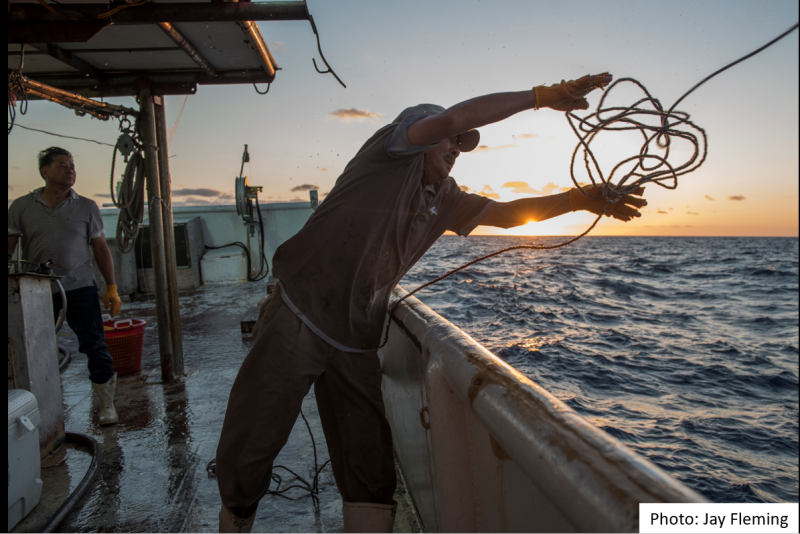The Oceanic Fish Restoration Project, part of restoration in the Gulf of Mexico after the Deepwater Horizon, is entering its final stages. The collaborative relationships between fishermen and NOAA that evolved during the project will last into the future.
Many oceanic fish species in the Gulf of Mexico were injured by the spill, including tuna, billfish, and mackerel, as well as deepwater fish such as lancetfish.
The Oceanic Fish Restoration Project is a unique partnership between NOAA and the National Fish and Wildlife Foundation. It partnered with Gulf of Mexico pelagic longline fishermen to help reduce fishing pressure on pelagic fish species.
Participating vessel owners were compensated to refrain from pelagic longline fishing for six months each year, from January 1 through June 30. They also received compensation to help offset their potential loss in revenue. During the repose, participants had the option to continue to fish using up to two of the three alternative gear types. The aim was to reduce bycatch (the unintended capture of non-target species), leaving more fish in the Gulf.
“After the fifth year of the project, the Louisiana fishermen are starting to see juvenile fish again, which is a big deal for the future of the fishery,” said Bobby Nguyen, a community liaison for the project. “Bringing back tuna and swordfish will benefit us here in the Gulf but also across the country—Gulf seafood is a national treasure.”
Many project participants reported a sense of hope and satisfaction from participating in the project.
WATCH: Hear what fishermen had to say about participating in the Oceanic Fish Restoration Project, and learn about other preliminary results from the effort.
“This project was a successful example of both collaborative and cooperative research,” added Gary Graham, who also participated as a community liaison. “Our focus was rebuilding the fishery. Without question, we reduced bycatch. We also answered a lot of questions about alternative gear and many fishermen plan to use the gear to supplement their fishing.”
Graham added that one participant even sold his pelagic longline boat to change his focus solely on buoy gear fishing off the coast of Florida.
According to another community liaison, “This is the first project where fishermen were included on day one. Fishermen were listened to—their inclusion, the feeling of being part of something—and they get pride in their work and want to continue.”
Participants echo this in feedback about their experience. One says: “I found it very rewarding to be a part of the project and experiment with the new gear, as well as to be a part of something that could help restore fish in the Gulf.”
The final participation phase wrapped up in 2022. Final data analysis will be completed and shared with the public later this year.
Project Background
From its kickoff in 2017, the project had broad participation from across the Gulf of Mexico, with participants from Louisiana, Florida, and Texas. Through 2022, 20 unique vessel owners participated in the project—about half the pelagic longline fleet in the Gulf. Some vessel owners participated for multiple years.
NOAA and the National Fish and Wildlife Foundation partnered with local community liaisons who worked directly with fishermen in the Gulf of Mexico. Liaisons also helped with translation with members of the fleet in Louisiana who spoke Vietnamese, alternative gear installation on vessels, and best practices training.
“Local community liaisons played critical parts in this project’s success,” said Ellen Bolen, the Foundation’s director of marine and coastal restoration. “The liaisons worked with participants to gain insight about what was working and what could be improved, and NOAA continually modified and enhanced the project based on this feedback.”
Preliminary Results
Through 2021, vessel owners’ participation in the project allowed approximately 1.6 million pounds of oceanic fish, including yellowfin tuna and bluefin tuna, to remain in the Gulf. Reducing fishing pressure on these stocks allowed more than 35,000 individual fish that would otherwise have been caught, to grow and reproduce.
Although alternative gear was found to have lower catch rates than pelagic longline gear, more than half of all fish discarded from alternative gear was released alive. Also, by allowing fishermen to continue to fish, it helped to offset some of the negative economic effects of the repose.
“The Louisiana participants worked together to learn the alternative gear,” adds Nguyen. “They communicated about the best techniques to catch more fish and other tips as they worked with the gear. This really brought the fleet back together to work as a unified group towards a common goal.”
A restored fishery and healthier Gulf will support robust fish stocks, benefiting vessel owners and others whose livelihoods rely on the fishery.
“Everybody that’s connected to this project is hoping to give a fighting chance for these fish to come back,” added Nguyen.



